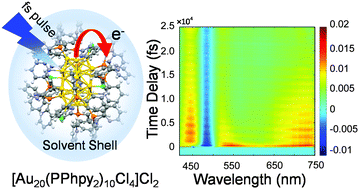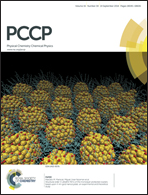Ultrafast relaxation dynamics of phosphine-protected, rod-shaped Au20 clusters: interplay between solvation and surface trapping†
Abstract
The exact interaction between Au cores and surface ligands remains largely unknown because of the complexity of the structure and chemistry of ligand/Au-core interfaces in ligand-protected Au nanoclusters (AuNCs), which are commonly found in many organic–inorganic complexes. Here, femtosecond transient absorption measurement of the excited-state dynamics of a newly synthesized phosphine-protected cluster [Au20(PPhpy2)10Cl4]Cl2 (1) is reported. Intramolecular charge transfer (ICT) from the Au core to the peripheral ligands was identified. Furthermore, we found that solvation strongly affected ICT at ligand/Au-core interfaces while by choosing several typical alcoholic solvents with different intrinsic solvation times, we successfully observed that excited-state relaxation dynamics together with displacive excited coherent oscillation of Au20 clusters were significantly modulated through the competition between solvation and surface trapping. The results provide a fundamental understanding of the structure–property relationships of the solvation-dependent core–shell interaction of AuNCs for the potential applications in catalysis, sensing and nanoelectronics.


 Please wait while we load your content...
Please wait while we load your content...